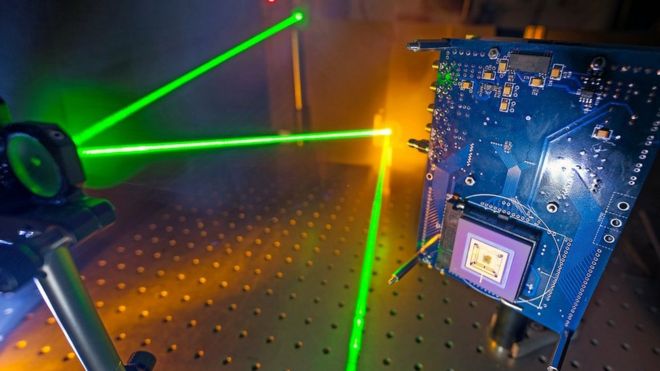Soon we’ll be able to see round corners and underground

Quantum sensors are set to make the invisible visible.Imagine a world where you can find out exactly what lies under your feet, get advanced warning of volcanic eruptions, look around corners or into rooms, and detect initial signs of multiple sclerosis.
Welcome to quantum sensing, a technology that could transform our world.At their heart, these sensors rely on the often baffling behaviour of subatomic particles, where the classical assumptions of Newtonian physics cease to exist.
“Quantum physics is said to be ‘spooky’, with particles being in two places at once, but it might be less spooky if you think of them as waves – and waves can be in several places at once,” says Prof Kai Bongs of Birmingham University.
Prof Bongs’ Birmingham team is part of a consortium of academics and businesses developing quantum gravity sensors or gravimeters that will be twice as sensitive and 10 times as fast as current equipment.
Quantum tech could “transform the world in ways we can barely imagine,” says Kai Bongs
This project, labelled Gravity Pioneer, could greatly simplify how engineers and surveyors plan and execute major construction projects.
Currently, the only way to find out what is underneath the ground is often to carry out exploratory digging, which is both time-consuming and expensive.
“Some have said that what lies below one metre under the streets of London is less well-known than Antarctica,” says Prof Bongs.
This is a major headache for construction companies who have to carry out surveys that can take days.
“There are thousands of mine shafts in the UK, often two metres or less across, and if the top of the shaft is five metres or more below ground then they can’t currently be detected,” explains George Tuckwell of engineering services firm RSK, which is leading the Gravity Pioneer project.
“But the new sensor will be able to see most of them.”
It uses rubidium atoms cooled by lasers to just above absolute zero (-273C) that are propelled upward in a vacuum and then measured as they fall back under gravity. Unknown underground structures, like tunnels or mine shafts, are a big risk for construction firms. It is so sensitive it can detect the tiny fluctuations in gravity that result from such relatively small underground structures. This should help speed up survey times, says engineering firm Teledyne e2V, which is turning Birmingham’s prototype into a commercial model.
Glasgow University researchers are working with Italian volcanologists to place a network of 40 tiny gravimeters on Sicily’s Mount Etna, one of the most active volcanoes in the world. As magma chambers fill up below ground their gravity readings will change, thus giving advanced warning of volcanic activity.
Italy’s Mount Etna is one of the world’s most active volcanoes
Scientists already use an array of instruments – such as seismometers, ground deformation recorders, gas monitors, infrared cameras and satellite imagers – to monitor volcanoes But a network of cheap and permanent gravimeters is a potential game changer, giving far more accurate readings of magma movements.
“Essentially, we will for the first time be able to provide gravity imaging for long time periods,” says Prof Giles Hammond at Glasgow’s Institute of Gravitational Research.
Using the current generation of bulky non-quantum gravimeters means scientists have to go on to the mountain and move them around – which has risks on an active volcano like Etna.The team is using micro- and nano-fabrication techniques to make tiny quantum gravimeters on silicon wafers that are 10 times cheaper than conventional models.
Glasgow’s new gravimeter is small – and a lot cheaper than current models.”Our sensor is a mass on a soft spring, and where that spring sits with a given mass is dependent on gravity. As gravity changes, where that spring sits also changes,” explains Prof Hammond.
The university is also working on a special 3D type of lidar that will enable you to look round corners, or “see” into a room. Conventional lidar measures the distance to an object by illuminating it with pulsed laser light and then measuring the reflected pulses. But quantum technology enables scientists to measure the arrival time of single photons with very high accuracy, in trillionths of a second. “In a canyon you’ll hear your voice echo back,” says Prof Daniele Faccio, head of Glasgow University’s Extreme Light group.
“You can do the same with light or a laser beam. The light will bounce off walls – so long as you have the geometry right. Then you can build a 3D image using this data.”
Quantum sensors in cars will enable cars to see round corners
The aim is to develop next-generation lidar for self-driving cars to give them enhanced awareness – through fog, smoke and over longer distances.Glasgow’s prototype sensor can already detect moving people 100m away, even when they’re a few metres round a corner.
Health benefits
Our detection of degenerative diseases is also set to change thanks to quantum sensing.While technology like MRI [magnetic resonance imaging] is already in use, quantum sensors are simpler, cheaper and have better resolution, says Sussex University’s Prof Peter Kruger.
“Quantum tech is a lot simpler and cheaper and has better resolution,” says Peter Kruger
“In diseases like multiple sclerosis, the processing speed of the spinal cord to the brain changes. But existing tools cannot pick this up,” he says.”New quantum sensors would be able to detect these changes in the way that MRI sensors can’t.”
Stealthy detection
Not surprisingly, militaries across the world are also backing research in to quantum sensing. Gravimeters in particular offer the potential for detecting your opponent’s submarines, for instance. Gravity may be a weak force, but you can’t shield against it. So while stealth technology may hide your radar signature, it won’t hide you from a quantum gravity sensor.
Last October, scientists at the US Army’s RDECOM Research Laboratory in Maryland took a significant step forward in quantum sensing. They used lasers to boost Rydberg atoms (which are much larger than normal atoms) to unusually high energy levels. “This greatly increases the atom’s sensitivity to electric fields. We’ve made a giant compass needle that is much more sensitive than conventional ones,” says Dr Paul Kunz, part of the research team.
Presentational grey line
Armies will want to detect what electrical devices may be transmitting or receiving data – in other words, “where the good guys and the bad guys are,” adds Dr Kevin Cox. Unlike conventional receivers designed to detect signals over a particular frequency in the electromagnetic spectrum, Rydberg atoms are sensitive to a wide range of frequencies. And as they don’t absorb energy from the field that they measure, you can use them to detect signals without your opponents realising.
In short, “quantum technology has the potential to transform the world in ways we can barely imagine,” concludes Birmingham University’s Prof Bongs.





